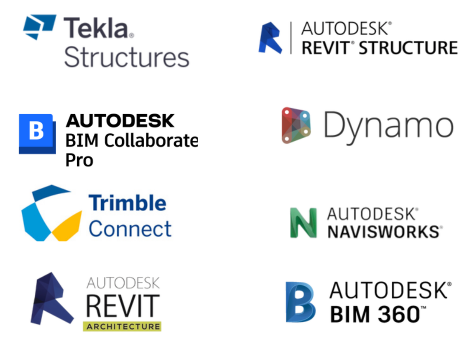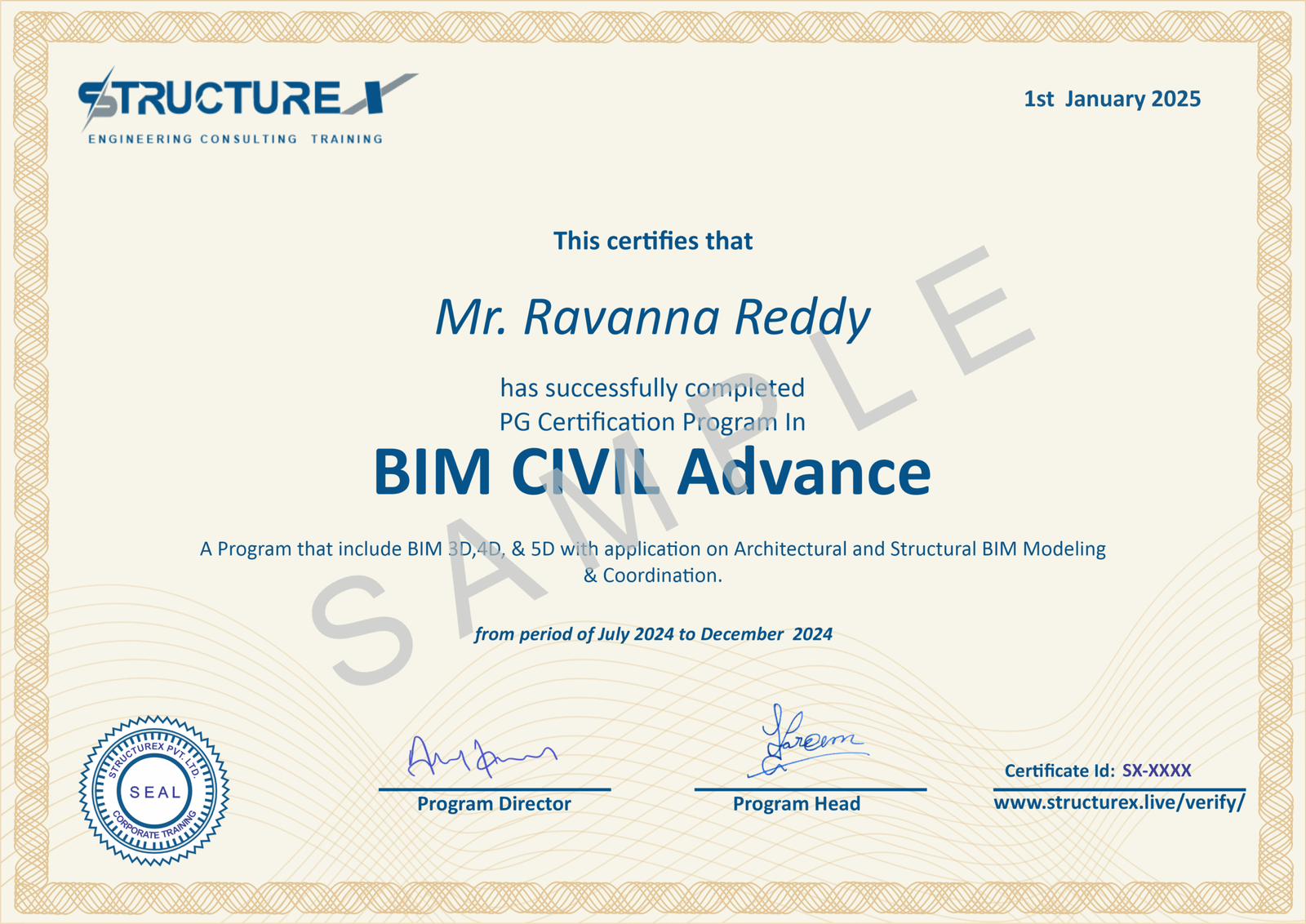PG Program in BIM Civil Advance
A six-month postgraduate program crafted for civil engineers and technicians to advance their expertise in BIM for a wide range of infrastructure projects, including buildings, bridges, and steel structures. The curriculum focuses on BIM modeling, coordination, and integrated project delivery, reinforcing the pivotal role of civil professionals in the AEC industry through a structured, multidisciplinary framework.
Program Duration
06 Month-Online
Upcoming Batch
01st Sept. 2025
our goal is to bridge the gap between engineering education and industry expectations by delivering hands-on, practical, and future-ready training programs. We aim to empower civil engineers, architects, and construction professionals with real-world skills in structural design, BIM, project execution, and software mastery, enabling them to become leaders in modern infrastructure and high-rise development.
Who can join this course.
To empower the next generation of civil and structural engineers through advanced, industry-oriented training, cutting-edge software integration, and global standards. We are committed to delivering excellence in education, fostering innovation, and bridging the gap between academic knowledge and practical engineering challenges to shape a more resilient and sustainable built environment.
To be a global leader in structural engineering education and innovation, driving transformation in the construction industry through technology, research, and skilled professionals equipped to design the skylines of tomorrow
Professional, Impactful & Job-Oriented
100%
Live session with e-learning support
140+
Learning Hour
6+
Industry relevent software
10+
Live Projects
learning BIM with Real world projects.
Course Objective
The PG Program in BIM Civil-Advance is a six-month, industry-focused training designed for civil engineers and technicians aiming to enhance their skills in Building Information Modeling (BIM) for diverse civil infrastructure projects. The course blends theoretical concepts with hands-on software training to prepare participants for high-demand BIM roles in the AEC (Architecture, Engineering & Construction) industry.

Course Description
The curriculum blends theoretical knowledge with hands-on training in industry-leading software such as Autodesk Revit, Navisworks, Tekla Structures, BIM 360, Trimble Connect, Dynamo, and Primavera, enabling participants to deliver fully coordinated, multi-dimensional (3D, 4D, 5D) BIM projects.
6+ Software
The course equips civil engineers and technicians with advanced BIM skills for infrastructure projects, using industry-leading software such as Autodesk Revit, Navisworks, Tekla Structures, BIM 360, Trimble Connect, Dynamo, and Primavera to deliver comprehensive modeling, coordination, and project management workflows.
100+
Learner Enrolled
50%
Salary Hike
40%
Multinational Learner
4.8/5
Google Review
Excellent Carriculum
Learning Path
0Week 02 : IT Session
week 02: Personal Intrection
Week 02: BIM Research (10 hrs.)
Week 03-09 : (REVIT) BIM Modelling (Structure+Architecture) (40 hrs.)
Week 10-19 :(Tekla structure) BIM Modelling of Bridge & Steel Structure
Week 19-20 : (Naviswork)BIM 4D 5D Clash Detection, Timeline, Costing
Week 21-22: Common Data Environment
Week 23-24 : (Dynamo) Visual Programing
Week 28-30: Assesment
Week 31-32 Career Assistance
BIM Research and Study
1Plan: Inform project planning by combining reality capture and real-world data to generate context models of the existing built and natural environment.
Design: During this phase, conceptual design, analysis, detailing and documentation are performed. The preconstruction process begins using BIM data to inform scheduling and logistics.
Build: During this phase, fabrication begins using BIM specifications. Project construction logistics are shared with trades and contractors to ensure optimum timing and efficiency.
Operate: BIM data carries over to operations and maintenance of finished assets. BIM data can be used down the road for cost-effective renovation or efficient deconstruction too.
Architecture Data
2Analysis: Optimize building performance in early-stage design, run cost estimates, and monitor performance over the lifetime of the project and the building.
Visualization: Generate photorealistic renderings. Create documentation with cutaways, 3D views, and stereo panoramas to extend your design to virtual reality.
Coordination and collaboration: Share, sync, and iterate designs with engineers and contractors in Revit in a unified project environment.
Structure Data
3BIM Structural Modelling is the core for any BIM Engineer. This Module cover various project type Live Projects:
1. Building structure (RCC)
2. Bridge structure
3. Steel Structure
Steel and Bridge Structure Modeling
4Steel Structure : Learning different type of steel structure PEB /Warehouse and others . Modeling, Detailing, Cost estimation, Fabrication and shop drawing, Connection modeling and their
component creation.
Bridge Structure : Learning different type of Bridge structure Guider RC/ Steel truss bridge. Modeling, Detailing, Cost estimation, Fabrication and shop drawing, Connection modeling and their
Common Data Environment
6The common data environment (CDE), is the single source of information used to collect, manage and disseminate documentation, the graphical model and non-graphical data for the whole project team,” says that “Creating this single source of information facilitates collaboration between project team members and helps avoid duplication and mistakes.”
BIM Simulation: Autodesk Navisworks
71.2 4D Simulation: Real timeline of project and clash detection
1.3 5D Cost Timeline of project (Costing)
1.4 6D Project life cycle information
Visual Programing
8Download Full Sybullash
Master 8 Software Tools

Typical project taken in program
We belive in learner review
We believe in the power of learner feedback to shape, improve, and inspire our programs

Mr. Vishnukant Dwivedi

Mr. Avinash Urkude

Mr. Kato Emmanuel

Mr. Mojeed Adesina

Mr. Krishna Sharma

Mr. Hugo Henrique

Mr. Sayandeep bhattacharjee

Er Avdhesh Negi

Mr. Ishan Nagar

Miss. Aurora Cako
Get certified as Professional Engineer

Enroll Today
Be a part of India’s top course provider, let’s start your application now!
Total Program fee
INR 70,000/-
Book your seat with INR 10,000/- only
Structurex Course benefit!
BIM Course Comparision Table
BIM Management
For Architecture, Engineer AEC professional.
Duration : 10 Month
Total Program fee
INR 11,00,00/-
PM & BIM – Advance
For BIM Modeler, Project Manager AEC Professional.
Duration : 06 Month
Total Program fee
INR 85,000/-
BIM CIVIL – Advance
For Civil Engineering and AEC professional.
Duration : 06 Month
Total Program fee
INR 70,000/-
BIM MEPF – Advance
For mechanical and electrical engineer professional.
Duration : 04 Month
Total Program fee
INR 62,000/-
Frequently Asked Questions
Why the course is 06 Month Long?
How much time reuired in a week?
👉 Each session is 2 hours
👉 Total: 6 to 8 hours/week of guided learning
Self-practice & assignments:
👉 Average 8 hours/week for project work, practice, and software.
Is this course live or recorded.
Do i need pre-knowldge to join this course.
What is the software included?
I dont have software installed on my pc. Can i still attend the course?
In which language course will deliver?
Is their any shorter version of this course?
How Can i solve my queries?
Do i get placement and career assistance after course complitation?
Is their gaurantee of Placement ?
From mock interviews to portfolio-building, we prepare you for the real industry.
Learn. Build. Get Hired — with StructureX.
What kind of certificate i will recive after course.
✅ Program Completion Certificate (STRUCTUREX PVT. LTD.)
Issued after completing all course modules and assessments.
✅ Internship Certificate
Recognizing your practical learning and hands-on software training during the course.
✅ Project Experience Certificate (Only upon successful submission of project work)
Awarded when you complete and submit an approved real-world project as part of the program.








